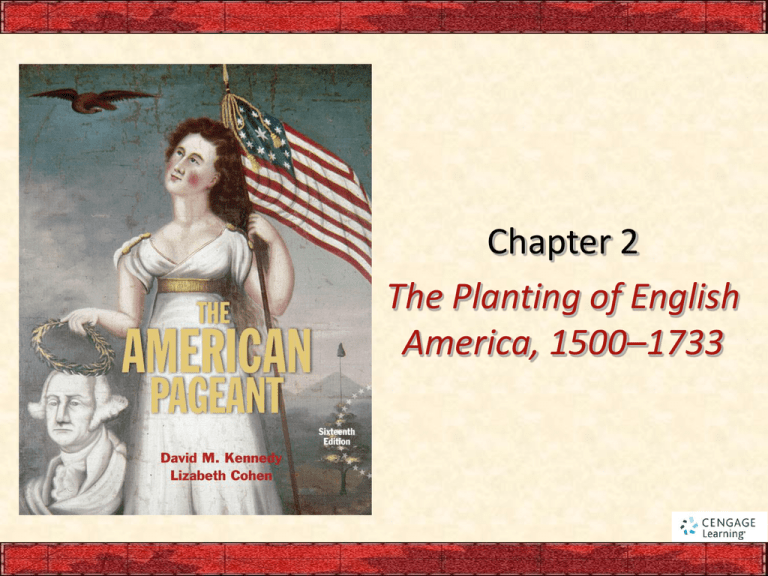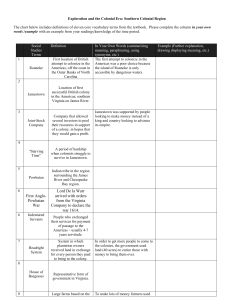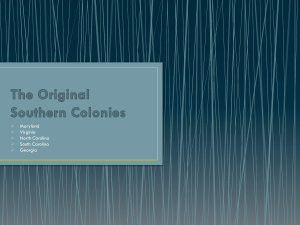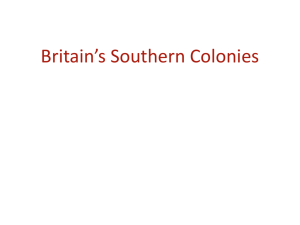Chapter 2 The Planting of English America, 1500–1733
advertisement

Chapter 2 The Planting of English America, 1500–1733 I. England’s Imperial Stirrings • In the 1500s England made feeble efforts to develop overseas colonies. • In the 1530s Henry VIII broke with the Roman Catholic Church, launching the English Protestant Reformation. • In 1558 Henry’s daughter, the Protestant Elizabeth I, became queen and established Protestantism in England. I. England’s Imperial Stirrings (cont.) • Catholic Ireland sought Catholic Spain’s help to throw off the new Protestant English queen. • Spanish aid amounted to little, and in the 1570s–1580s Elizabeth’s troops crushed the Irish uprising. • English soldiers developed a sneering contempt for the “savage” natives, an attitude they took to the New World. II. Elizabeth Energizes England • In 1577 English semipiratical “sea dogs” under Sir Francis Drake circumnavigated the globe. • The first English attempt at colonization was off the coast of Newfoundland. • In 1585 Sir Walter Raleigh landed on North Carolina’s Roanoke Island. • Virginia was named in honor of Elizabeth, the “Virgin Queen.” II. Elizabeth Energizes England (cont.) • In 1588 England defeated the Spanish Armada, marking the end of Spain’s imperial dreams. • After victory, the English started to become masters of the world oceans—with important consequences for the American people. • England had strong national characteristics. Table 2.1 p26 p26 III. England on the Eve of Empire • England experienced strong economic and social changes and a “surplus population.” • Laws of primogeniture meant that only eldest sons were eligible to inherit landed estates. • By the early 1600s, the joint-stock company was perfected. • Peace with Spain provided the opportunity for English colonization. p28 IV. England Plants the Jamestown Seedling • 1603: James I became king of England. • 1606: Virginia Company of London received a charter to settle in the New World. • This charter is significant; guaranteed settlers the same rights as Englishmen. • On May 24, 1607, the Virginia colony of Jamestown was founded (see Map 2.1). • John Smith was key to the colony’s survival. Map 2.1 p29 p29 V. Cultural Clashes in the Chesapeake • In 1607 Chieftain Powhatan dominated the James River area. • In 1610 Lord De La Warr arrived from England with orders to deal with the Indians. • In 1614 the First Anglo-Powhatan War ended, sealed by Pocahontas’s marriage to colonist John Rolfe—the first known interracial union in Virginia. V. Cultural Clashes in the Chesapeake (cont.) • Second Anglo-Powhatan War (1644) was Indians’ last attempt to dislodge Virginians. • The Powhatans’ misfortune was the three Ds: disease, disorganization, and disposability. • “Powhatan’s Confederacy” lacked unity to oppose the disciplined whites. • The Powhatans served no economic function for colonists. p30 VI. The Indians’ New World • Indigenous people’s destinies had changed. • The shock of large-scale European colonization disrupted Native American life. • Horses, diseases, trade, and the expanding Atlantic economy transformed Indian life. • A new middle ground compelled both Europeans and Native Americans to accommodate each other. p31 VII. Virginia: Child of Tobacco • In 1612 John Rolfe perfected tobacco culture. • Virginia’s prosperity was built on this “bewitching weed,” but King Nicotine depleted the soil. • Besides land, tobacco required lots of labor. • In 1619 a Dutch warship landed at Jamestown and sold some twenty Africans, planting the seeds of North American slavery. p32 VII. Virginia: Child of Tobacco (cont.) • In 1619 representative self-government was born in primitive Virginia. • The House of Burgesses was an assembly or miniature parliament in the New World. • James I grew increasingly hostile to Virginia. • In 1624 he revoked the company’s charter and Virginia became a royal colony. VIII. Maryland: Catholic Haven • 1634: Maryland, 2nd plantation colony, was founded by Lord Baltimore partly as a refuge for Catholics. • Resentment between Catholics and Protestants flared into open rebellion. • The Baltimore family for a time lost its proprietary rights, but the colony prospered. • As in Virginia, indentured servants initially provided labor for the tobacco economy. VIII. Maryland: Catholic Haven (cont.) • Lord Baltimore permitted unusual freedom of worship at the outset. • In 1649 the local assembly passed the famed Act of Toleration guaranteeing toleration to all Christians. • However, it decreed the death penalty for Jews and atheists, who denied the divinity of Jesus. IX. The West Indies: Way Station to Mainland America • England secured claims to several West Indian islands, including Jamaica in 1655. • Their economy was based on sugar. • Had different requirements than tobacco. • Many enslaved Africans were imported to work the sugar plantations. • Black slaves eventually outnumbered white settlers. p34 p34 IX. The West Indies: Way Station to Mainland America (cont.) • 1661: Barbados slave code defined slaves’ legal status and their masters’ prerogatives. • Profitable sugar plantations crowded out most other forms of Caribbean agriculture. • 1670: Displaced settlers from Barbados arrived in Carolina with their slaves. • 1696: Carolina adopted the Barbados slave code, which eventually shaped slave laws throughout the mainland. X. Colonizing the Carolinas • In the 1640s civil war convulsed England. • After 1660 empire building resumed during the Restoration period (see Table 2.2). • In 1670 Carolina was created, and it formed close links with the English West Indies. • Rice emerged as its principal export crop. • Charles Town was busiest seaport in South; Carolina survived Spanish and Indian attacks. Table 2.2 p35 XI. The Emergence of North Carolina • North Carolina has been called “the quintessence of Virginia’s discontent.” • “Squatters” (newcomers without legal rights to the soil) raised crops on small farms. • Distinctive traits developed. • In 1712 North Carolina officially separated from South Carolina (see Map 2.2). Map 2.2 p36 XI. The Emergence of North Carolina (cont.) • North Carolina shared with tiny Rhode Island several distinctions: – Most democratic – Most independent-minded – Least aristocratic of original thirteen English colonies XI. The Emergence of North Carolina (cont.) • Relations between Indians and Europeans were bloody: – 1711–1713: Tuscarora War. – Displaced, the Tuscaroras later became the Sixth Nation of the Iroquois Confederacy. – After war with the Yamasee Indians in South Carolina (1715–1716), most coastal tribes were devastated. • But tribes in the interior remained strong. XII. Late-Coming Georgia: The Buffer Colony • In 1733 Georgia was founded as a buffer to protect the Carolinas. • It was named in honor of King George II of England. • Launched by a group of philanthropists, it would also serve as a haven for debtors. • Georgia was called “the Charity Colony.” XII. Late-Coming Georgia: The Buffer Colony (cont.) • Georgia founders wanted no slavery. • James Oglethorpe, a key founder, helped ensure the colony’s survival. • Savannah, like Charleston, became a meltingpot community. • John Wesley served as a missionary. • Georgia grew more slowly than other colonies. XIII. The Plantation Colonies • England’s southern mainland colonies shared: – Devotion to exporting agricultural products, mainly tobacco and rice – Slavery – Slow growth of cities – Religious toleration – A tendency to expand Map 2.3 p38 p38 p39 p40



